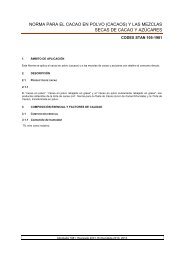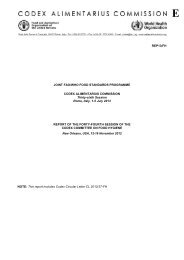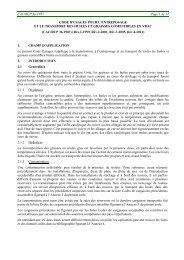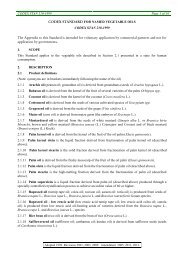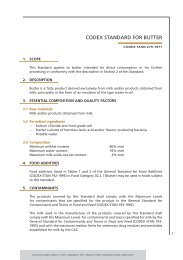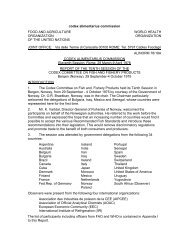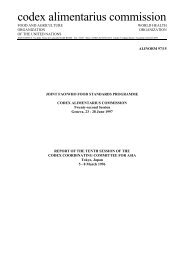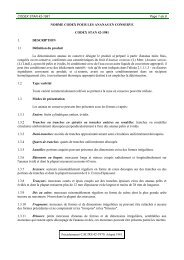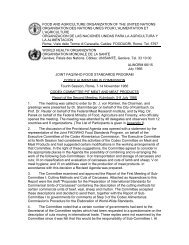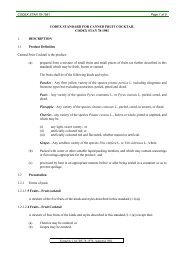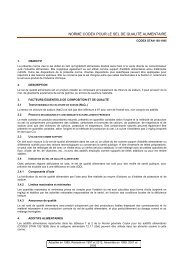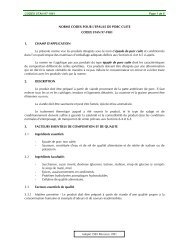codex alimentarius commission FOOD AND AGRICULTURE ...
codex alimentarius commission FOOD AND AGRICULTURE ...
codex alimentarius commission FOOD AND AGRICULTURE ...
Create successful ePaper yourself
Turn your PDF publications into a flip-book with our unique Google optimized e-Paper software.
(e)<br />
(f)<br />
Determination of Vitamin K<br />
No proposals for suitable methods were available as yet.<br />
Determination of Vitamin D and E<br />
No suitable methods could be proposed at the present time. However,<br />
methods for the determinations based on HPLC were in preparation.<br />
(g)<br />
Determination of Linoleic Acid<br />
The Commission for Fats and Oils of IUPAC had elaborated a method for<br />
the determination of cis-cis 1:4 polyene acids. The quantity of linoleic acid could<br />
be determined by this method in combination with a G.L.C. method.<br />
The Chairman of the Working Group was asked to make these methods<br />
available to the members of the Working Group.<br />
The Chairman of the Committee thanked the Working Group for its valuable<br />
work. The Committee agreed with the conclusions of the Working Group and<br />
recommended that matters be followed up as indicated in the above report of the<br />
Working Group.<br />
CODE OF HYGIENIC PRACTICE FOR <strong>FOOD</strong>S FOR INFANTS <strong>AND</strong> CHILDREN<br />
90. At the 13th Session of the Codex Alimentarius Commission, this Code was<br />
adopted at Step 8 except for the microbiological specifications contained in Annex I to<br />
the Code and the methods for microbiological analysis contained in Annex II (see also<br />
Appendix VII to ALINORM 79/26). The Commission deferred any decision concerning<br />
Annexes I and II but gave due regard to the views of the Committee about the advisory<br />
nature of the specifications.<br />
91. Several delegations informed the Committee that, in their countries,<br />
microbiological end-product specifications for infant foods were mandatory. They were<br />
therefore in favour of the specifications being mandatory rather than advisory. The<br />
majority of delegations expressed the opinion that the specifications should be advisory<br />
for the time being. One delegation expressed the view that the specifications were too<br />
strict and that they would want to see some revision of the limits for bacterial counts.<br />
(Part II, para. 4 of CX/FSDU 80/7). The Committee agreed that the specifications<br />
included in the Code were of advisory nature. It was noted that countries having<br />
mandatory provisions for these microbiological specifications could specify this as a<br />
deviation when accepting the Codex Standards for Foods for Infants and Children. In<br />
view of the deviations notified, this Committee could reconsider at a future session,<br />
whether the microbiological specifications should be advisory or mandatory. '<br />
92. The Committee noted that a Circular Letter had been sent in August 1980 to<br />
Codex Contact Points for comments on the two annexes at Step 6 and that the<br />
comments would be considered by the next session of the Codex Committee on Food<br />
Hygiene (November 1980) which would also have before it the views of this Committee.<br />
WHO/UNICEF INTERNATIONAL CODE OF MARKETING OF BREASTMILK<br />
SUBSTITUTES <strong>AND</strong> RELATED PRODUCTS<br />
93. The representative of WHO outlined briefly the history of the proposed Draft<br />
International Code of Marketing of Breastmilk Substitutes. In October 1979, WHO and<br />
UNICEF had held a meeting at WHO Headquarters of representatives from all<br />
governments and organizations who were interested in the feeding of Infants and Young<br />
Children. The Meeting had recommended that an international code of marketing of



